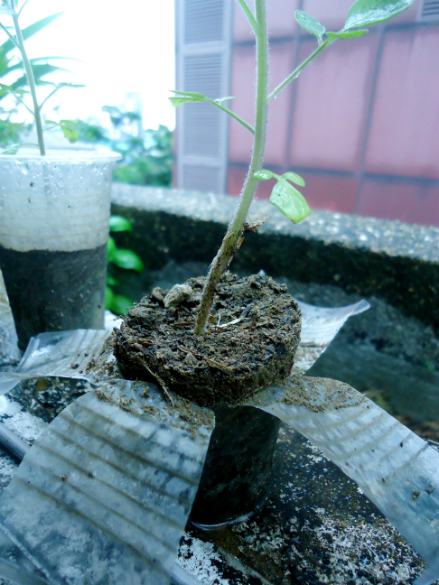
- #CHERRY TOMATO SEEDLINGS GROWING HORIZONTALLY FULL#
- #CHERRY TOMATO SEEDLINGS GROWING HORIZONTALLY TRIAL#
#CHERRY TOMATO SEEDLINGS GROWING HORIZONTALLY FULL#
We grow thousands of organic transplants, including dozens of varieties of tomatoes to share, so visit on a Saturday or Sunday between 10 and 2 through the first weekend in June! For our full list of available transplants, hop on over here. Our goal with any transplant is to grow the shortest, stoutest and deepest green transplant we possibly can. We start our tomatoes ~6 weeks before final frost. Grow or Find Yourself a Gorgeous Transplant Without further ado, here are the 7 Steps to Transplanting Tomatoes: 1. Wait til both the soil and air temps are consistently cozy (above 55 F) and their growth will be quick, healthy and the subsequent abundance astonishing. You can plant early and cover such crops, but I’ve found it’s largely not worth it. Every time.Īlso, think of tomatoes, basil, peppers and other warm season crops as ‘cold-sensitive’ rather than ‘frost-sensitive.’Ī pepper, for example, experiencing temps less than 55 F will cross her proverbial arms and pout for a few weeks (if not months) in protest of her apparent lack of proximity to the equator, the cradle of her evolution. It’s counter-intuitive in our short seasons to not plant warm-season plants like tomatoes as early as possible, but here’s the thing: Young, healthy transplants yield greater abundance compared to older, stressed transplants.


#CHERRY TOMATO SEEDLINGS GROWING HORIZONTALLY TRIAL#
Here is exactly how we transplant tomatoes, after years of trial and error, and I hope these keys surround you with great abundance! Doing it well is the difference between harvesting a bit and harvesting abundance. Once the seeds are completely dry, store them in a cool, dry location for up to four years.Here in Zone 5, we’re so ready to transplant tomatoes.Īnd Friends, transplanting is deceptively simple. Stir them twice a day, and provide a fan to speed drying if the air is humid. Rinse the seeds in a strainer under running water until they are clean, then spread them out to dry in a protected location away from direct sunlight. Pour off the mold and debris, saving the good seeds on the bottom. Let the mixture ferment for several days or until a thick layer of mold has formed this process removes the gelatinous layer on the seeds. An alternative method for smaller tomatoes is to put them in a blender and pulse the mixture, since these heirloom cherry tomato seeds are hard and slippery and will not be harmed. Pick fully ripe red cherry heirloom tomatoes and cut them in half horizontally, across the middle squeeze out the pulp into a container. Seed Saving: Since cross pollination between most tomato varieties is unlikely, isolation is not a concern. Unripe tomatoes will ripen eventually if kept in a warm place out of direct sunlight. Vine ripened red cherry heirloom tomatoes have the best flavor, but as soon as frost comes, all tomatoes should be harvested, even the green ones. If the stem does not come easily off the vine, cut it with a scissors. The mature color also indicates ripeness. Harvesting: Test the ripeness of tomatoes by pressing them gently the flesh should yield slightly. Pruning the "suckers," or shoots that grow between the main stem and the branches, will greatly improve the production and strength of the plant. A thick layer of mulch helps conserve moisture and control weeds water the plants once a week, but avoid getting the leaves wet. Since temperatures below 55 degrees F can damage production, protect the plants if temperatures drop. As the vines begin to grow, tying them to the support helps their development. Put the supports in place before the seedlings develop vines. Growing: Indeterminate tomato varieties often perform best when provided with a trellis or support, since this protects them from various pests and diseases in connection with too much soil contact. For companion planting benefits, plant tomatoes with carrots or onions, but avoid planting them with cabbage or tomatoes. If providing a trellis, space the plants 2' apart, but if allowing the vines to spread, space the plants 3-4' apart. When the soil temperature reaches at least 70 degrees F, plant the seedlings in full sun and very rich soil once more, bury the entire stem up to the lowest set of leaves.

A week before planting the seedlings outside, begin exposing them to the weather during the day to harden them tomatoes cannot endure cold weather, and should not be transplanted outside until all threat of frost has passed. When the second set of leaves emerges, transplant the seedlings into individual pots bury the stems up to the lowest set of leaves to grow strongly rooted plants. Keep the temperature at 70-75 degrees F until germination, as well as providing adequate light in a sunny window or under a grow light keep the soil moist, but make sure drainage is adequate.

Sowing: Start tomatoes indoors 6-8 weeks before the last frost of spring, sowing the seeds in a flat 1/4" deep and 1" apart.


 0 kommentar(er)
0 kommentar(er)
